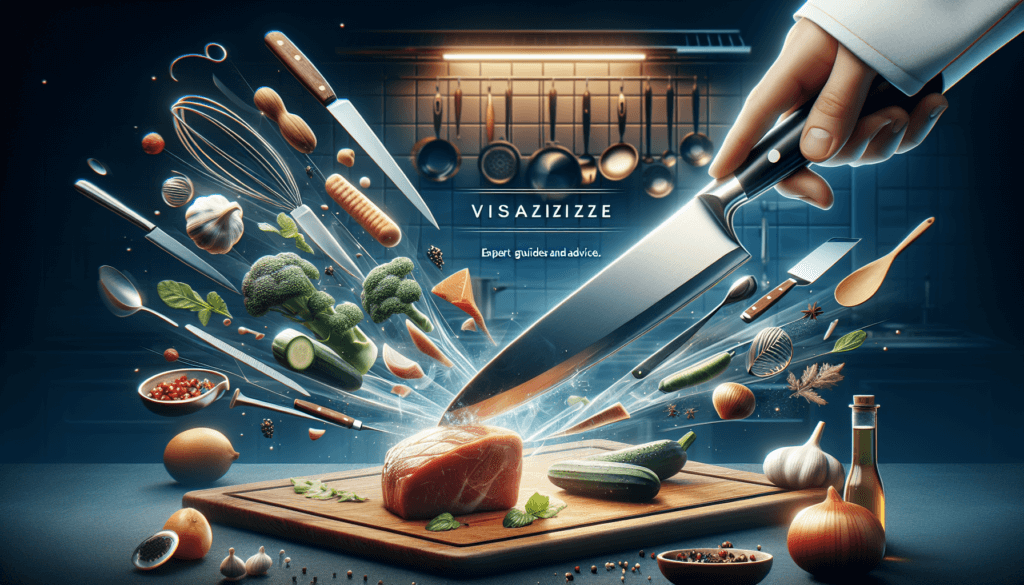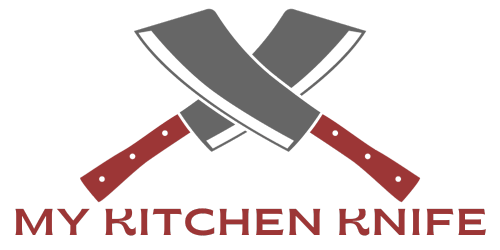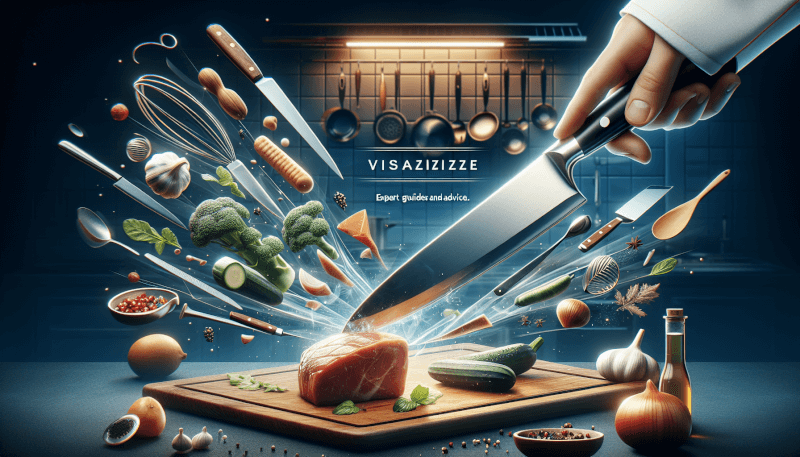Are you tired of struggling with dull and inefficient knives when it comes to slicing meat and fish in the kitchen? Look no further! In this article, we will share valuable tips to help you find the perfect kitchen knife specifically designed for this task. From understanding the different types of blades to considering the handle material, we have got you covered. Say goodbye to uneven slices and hello to effortless food preparation with the ideal kitchen knife. So, let’s get started on your journey to becoming a slicing pro!
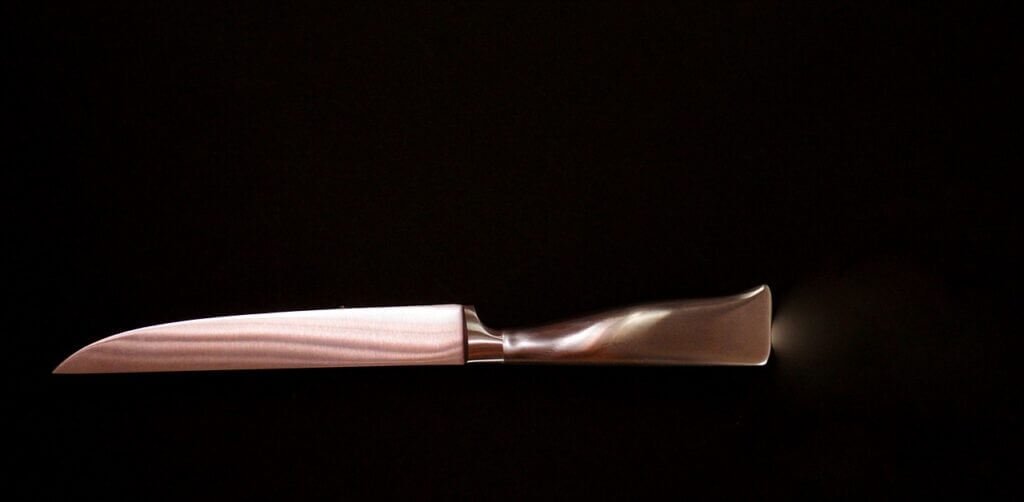
Consider the Blade Type
When it comes to finding the perfect kitchen knife for slicing meat and fish, one of the first considerations is the blade type. Different blade types offer different advantages and are suited for different tasks.
Serrated Blades
Serrated blades are a popular choice for slicing through tough cuts of meat or crusty breads. The serrations on the blade enable it to grip the surface of the food, making it easier to slice through without squishing or tearing. These blades are also useful for slicing through delicate foods, such as tomatoes, without damaging their structure.
Straight Blades
Straight blades are versatile and can be used for a variety of kitchen tasks, including slicing meat and fish. Their sharp, plain straight edges allow for precise and clean cuts, making them ideal for slicing boneless meats or filleting fish. Straight blades also make it easier to achieve thin and even slices, which is especially important in tasks such as carving roast beef or slicing sushi.
Hollow Edge Blades
Hollow edge blades, also known as granton edge blades, feature small indents or grooves along the edge of the blade. These indents create air pockets between the food and the blade, reducing friction and enabling thin slices to be easily released from the knife. Hollow edge blades are particularly useful for slicing thin cuts of meat, such as prosciutto or smoked salmon, where precision and presentation are key.
Blade Material Matters
The material of the blade is another crucial factor to consider when selecting a kitchen knife for slicing meat and fish. Different materials offer different properties in terms of sharpness, durability, and maintenance requirements.
Stainless Steel
Stainless steel blades are popular for their corrosion resistance and ease of maintenance. They are highly durable, resistant to staining, and require minimal sharpening. Stainless steel blades also provide good edge retention, allowing them to maintain their sharpness for longer periods. They are a reliable choice for everyday use in the kitchen and are available in a wide range of price points.
High Carbon Steel
High carbon steel blades are known for their exceptional sharpness and edge retention. They offer superior cutting performance and are capable of maintaining their razor-like edge for prolonged periods. However, high carbon steel blades are more prone to corrosion and require regular maintenance and oiling to prevent rust. They also tend to be more expensive than stainless steel blades.
Ceramic
Ceramic blades are lightweight, extremely sharp, and have excellent edge retention. They do not rust or corrode, making them low-maintenance and easy to clean. However, ceramic blades are more brittle than stainless steel or high carbon steel blades and can chip or break if mishandled or subjected to excessive force. They are best suited for slicing boneless meats and fish, as they are not designed for cutting through hard surfaces.
Damascus Steel
Damascus steel blades are prized for their stunning aesthetic appeal and exceptional performance. These blades are created by layering different types of steel together and forging them into one blade. The resulting pattern and texture of Damascus steel make each blade unique and visually striking. In addition to their beauty, these blades offer excellent sharpness, durability, and corrosion resistance. However, Damascus steel knives are often more expensive and require regular maintenance to prevent rust.
Weight and Balance
The weight and balance of a kitchen knife are critical factors to consider for both comfort and control during slicing.
Optimal Weight
The weight of a knife should feel balanced and comfortable in your hand. The ideal weight will vary depending on personal preference and the specific task at hand. Some prefer a heavier knife, as it can provide more cutting power, while others prefer a lighter knife for increased maneuverability. It is important to choose a knife weight that feels comfortable and allows for precise control.
Balanced Distribution
In addition to overall weight, the balance of the knife is equally important. The knife should feel balanced when held at the bolster or the area where the blade meets the handle. A well-balanced knife will make it easier to control and handle, reducing fatigue during prolonged use. To find the right balance, hold the knife at the bolster and see if it feels evenly weighted in your hand.
Handle Ergonomics
The handle of a kitchen knife plays a significant role in comfort and grip. It should be designed to fit comfortably in your hand and provide a secure grip to ensure safe and efficient slicing.
Comfort and Grip
Consider the shape, size, and texture of the handle. A handle that is ergonomically designed with contours that fit the natural curves of your hand will offer better comfort during prolonged use. The handle should be neither too small nor too large, ensuring a secure and comfortable grip. Additionally, a textured or non-slip handle can provide added grip and prevent the knife from slipping out of your hand, particularly if your hands are wet or greasy.
Handle Material
Kitchen knife handles are commonly made of various materials, including wood, plastic, stainless steel, or composite materials. Each material has its own unique advantages and considerations. Wood handles offer a warm and natural feel, but they may require more maintenance to prevent cracking or warping. Plastic handles are affordable, lightweight, and easy to clean, but they may lack the durability and aesthetic appeal of other materials. Stainless steel handles are sleek, hygienic, and durable, but they can be more slippery when wet. Composite materials, such as fiberglass or G-10, offer a combination of durability, grip, and aesthetics.
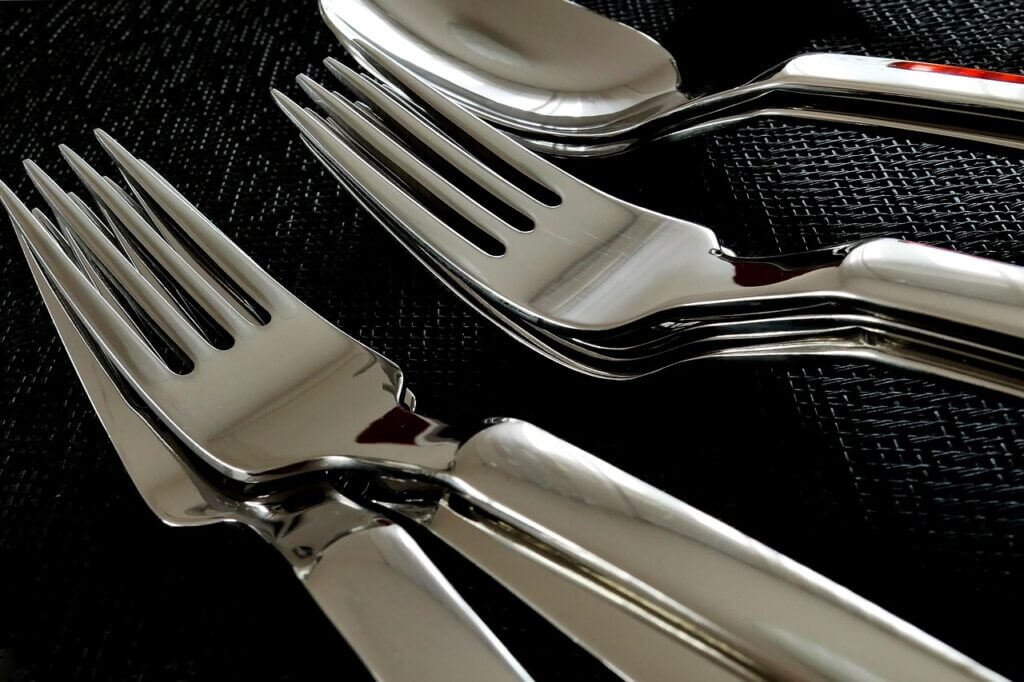
Blade Length
The length of the blade is an important factor to consider, as it determines the ease and precision of slicing meat and fish.
Length for Meat Slicing
For slicing meat, the length of the blade should be chosen based on the size of the cuts you typically work with. A longer blade, such as 8 to 10 inches, is suitable for larger cuts of meat, such as roasts or whole poultry. It allows for longer strokes and easier slicing through thick pieces of meat. Conversely, a shorter blade, around 6 to 7 inches, is ideal for slicing smaller cuts of meat, such as steaks or boneless chicken breasts.
Length for Fish Slicing
When it comes to slicing fish, a flexible blade is essential for precision and minimizing damage to the delicate flesh. The length of the blade will depend on the size of the fish you typically work with. For smaller fish, a blade length of around 6 to 8 inches is suitable, while larger fish may require a longer blade of 9 to 12 inches. The flexibility of the blade allows it to smoothly glide along the contours of the fish, ensuring clean and precise cuts.
Edge Retention
The ability of a knife to maintain its sharpness over time is crucial for efficient slicing. Consider the edge retention properties of different blades to ensure long-lasting sharpness.
Long-lasting Sharpness
Blades with excellent edge retention properties will stay sharp for prolonged periods, reducing the need for constant sharpening. High carbon steel and Damascus steel blades are known for their superior edge retention capabilities, allowing them to retain their sharpness even with frequent use. Stainless steel blades can also offer good edge retention, especially when made with high-quality steel.
Edge Maintenance
Regardless of the blade material, regular maintenance is necessary to keep the edge sharp. Honing the blade with a honing steel or ceramic rod can help realign the microscopic teeth of the blade, maintaining its sharpness. Additionally, periodic sharpening using a whetstone or sharpening system will be required to restore the knife’s edge. Consider your willingness and ability to properly maintain the blade when selecting the knife.
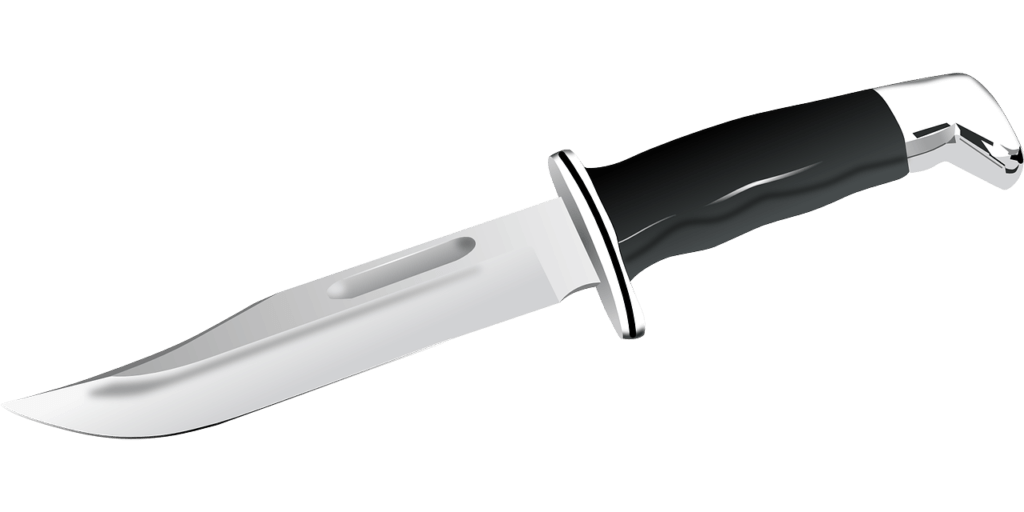
Durability and Sturdiness
Durability and sturdiness are essential qualities to look for in a kitchen knife, ensuring it can withstand the rigors of slicing meat and fish.
Knife Construction
The construction of the knife refers to how the blade is connected to the handle. The two most common types of construction are forged and stamped knives. Forged knives are made from a single piece of metal, providing strength, durability, and excellent balance. Stamped knives, on the other hand, are cut from a single sheet of metal and are generally lighter and less expensive. While both types can be suitable for slicing meat and fish, forged knives are often preferred for their superior durability and performance.
Tang Style
The tang refers to the part of the blade that extends into the handle. Full tang knives have the blade extending the full length of the handle, providing added strength and stability. Partial tang knives have a shorter portion of the blade extending into the handle, which can make them more prone to breaking or becoming loose over time. Opting for a full tang knife will ensure durability and a knife that will last for years to come.
Consider your Budget
Before making a purchase, it is essential to determine your budget. Kitchen knives can vary widely in price, and setting a budget will help narrow down your options.
Determining your Budget
Consider how much you are willing to invest in a kitchen knife. Keep in mind that higher-priced knives often offer superior performance, durability, and luxurious materials. However, there are also excellent options available at more affordable price points. It’s important to find the right balance between your budget and the quality of the knife you desire.
Quality vs. Cost
While cost is an important factor, it should not be the sole criterion when choosing a kitchen knife. It is crucial to strike a balance between quality and cost. A high-quality knife that meets your needs and offers long-lasting performance is a worthwhile investment, even if it comes with a higher price tag. However, this does not mean that you cannot find an affordable knife that meets your requirements. Researching and reading reviews can help you find knives that offer excellent value for your budget.
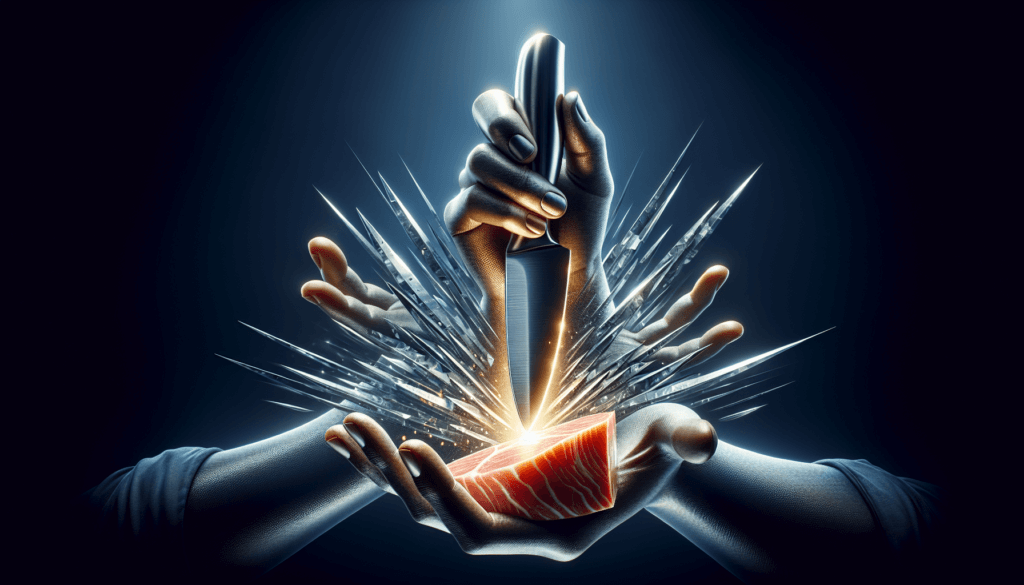
Safety Features
Safety should always be a priority when working with sharp kitchen knives. Consider the safety features offered by different knives to ensure peace of mind during slicing tasks.
Knife Guards
Many knives come with protective knife guards that cover the blade when not in use. These guards provide a physical barrier, preventing accidental cuts and protecting the blade from damage. Knife guards are especially useful for safely storing and transporting knives, ensuring that they do not cause any harm or become dulled by rubbing against other objects.
Finger Protectors
Some knives may include finger protectors or ergonomic features in their design to minimize the risk of accidental slips or cuts. These features can provide added grip and protection, reducing the chances of injuring your fingers while slicing through meat or fish. Finger protectors are particularly useful for those who may have less experience handling knives or are concerned about safety.
Test the Knife
Before finalizing your decision, it is crucial to test the knife in person whenever possible. Testing the knife will allow you to assess its grip, comfort, and overall performance.
Grip and Comfort
Hold the knife in your hand, taking note of how it feels. Does the handle fit comfortably, allowing you to maintain a secure grip? Is the weight and balance to your liking? A knife that feels comfortable and provides a secure grip will ensure better control and reduce the risk of accidents or discomfort during use.
Test Slicing
If possible, try slicing through a piece of meat or fish to get a feel for the knife’s performance. Pay attention to how smoothly it glides through the food and the ease with which you can achieve thin and even slices. Testing the knife in action will provide valuable insights into its cutting ability and suitability for your specific slicing tasks.
Finding the perfect kitchen knife for slicing meat and fish is a highly personalized process. By considering the blade type, blade material, weight and balance, handle ergonomics, blade length, edge retention, durability and sturdiness, budget, safety features, and testing the knife, you can make an informed decision that will enhance your culinary experience and make slicing tasks a breeze. Remember to prioritize quality, comfort, and safety to find the knife that meets your needs and brings joy to your time in the kitchen. Happy slicing!
